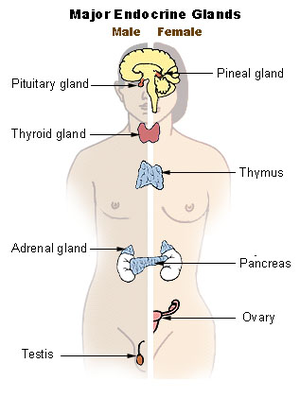Difference between revisions of "Endocrine System"
| Line 14: | Line 14: | ||
:*[[Ovary|Ovaries]] | :*[[Ovary|Ovaries]] | ||
:*[[Testis|Testes]] | :*[[Testis|Testes]] | ||
| + | |||
| + | |||
| + | ===References=== | ||
| + | ====AQA==== | ||
| + | |||
| + | :[https://www.amazon.co.uk/gp/product/0198359373/ref=as_li_tl?ie=UTF8&camp=1634&creative=6738&creativeASIN=0198359373&linkCode=as2&tag=nrjc-21&linkId=952a73bbb09d222ecc4b50d200679849 ''Endangered species, page 298, GCSE Biology; Third Edition, Oxford University Press, AQA ''] | ||
| + | :[https://www.amazon.co.uk/gp/product/1782946381/ref=as_li_tl?ie=UTF8&camp=1634&creative=6738&creativeASIN=1782946381&linkCode=as2&tag=nrjc-21&linkId=5ec5fc3f6429e30c1d9ab9bca2bccf93 ''Endocrine system, page 181, GCSE Combined Science Trilogy; Biology, CGP, AQA ''] | ||
| + | :[https://www.amazon.co.uk/gp/product/1782945954/ref=as_li_tl?ie=UTF8&camp=1634&creative=6738&creativeASIN=1782945954&linkCode=as2&tag=nrjc-21&linkId=100574c08fbbb64318256eb79ed61a76 ''Endocrine system, page 207, GCSE Biology, CGP, AQA ''] | ||
| + | :[https://www.amazon.co.uk/gp/product/1782945598/ref=as_li_tl?ie=UTF8&camp=1634&creative=6738&creativeASIN=1782945598&linkCode=as2&tag=nrjc-21&linkId=ad276ad49df77ab4b40ab4fd0fe09893 ''Endocrine system, page 61, GCSE Combined Science; The Revision Guide, CGP, AQA ''] | ||
| + | :[https://www.amazon.co.uk/gp/product/1782945563/ref=as_li_tl?ie=UTF8&camp=1634&creative=6738&creativeASIN=1782945563&linkCode=as2&tag=nrjc-21&linkId=9a1d023a374038e6072f33c4f3cf808b ''Endocrine system, page 73, GCSE Biology; The Revision Guide, CGP, AQA ''] | ||
| + | :[https://www.amazon.co.uk/gp/product/1471851362/ref=as_li_tl?ie=UTF8&camp=1634&creative=6738&creativeASIN=1471851362&linkCode=as2&tag=nrjc-21&linkId=7d78d70a2044ee9982dae010c94af92a ''Endocrine system, pages 12-13, GCSE Combined Science Trilogy 2, Hodder, AQA ''] | ||
| + | :[https://www.amazon.co.uk/gp/product/0008158754/ref=as_li_tl?ie=UTF8&camp=1634&creative=6738&creativeASIN=0008158754&linkCode=as2&tag=nrjc-21&linkId=27ad53b0283feeff7fc5ae04a9e205f261 ''Endocrine system, pages 171, 172-3, 190-1, 215, GCSE Biology; Student Book, Collins, AQA ''] | ||
| + | :[https://www.amazon.co.uk/gp/product/0198359373/ref=as_li_tl?ie=UTF8&camp=1634&creative=6738&creativeASIN=0198359373&linkCode=as2&tag=nrjc-21&linkId=952a73bbb09d222ecc4b50d200679849 ''Endocrines system, pages 160-175, GCSE Biology; Third Edition, Oxford University Press, AQA ''] | ||
Revision as of 11:15, 4 November 2019
Key Stage 4
Meaning

This diagram shows several endocrine glands in the endocrine system. NB: You do not need to know the thymus or pineal gland.
The endocrine system is an organ system made of several glands which produce hormones.
About the Endocrine System
- The endocrine system is used to coordinate the behaviour of specific organs in the body.
- The endocrine system consists of endocrine glands which produce hormones that affect the functioning of target organs.
- The glands in the endocrine system you should know are:
References
AQA
- Endangered species, page 298, GCSE Biology; Third Edition, Oxford University Press, AQA
- Endocrine system, page 181, GCSE Combined Science Trilogy; Biology, CGP, AQA
- Endocrine system, page 207, GCSE Biology, CGP, AQA
- Endocrine system, page 61, GCSE Combined Science; The Revision Guide, CGP, AQA
- Endocrine system, page 73, GCSE Biology; The Revision Guide, CGP, AQA
- Endocrine system, pages 12-13, GCSE Combined Science Trilogy 2, Hodder, AQA
- Endocrine system, pages 171, 172-3, 190-1, 215, GCSE Biology; Student Book, Collins, AQA
- Endocrines system, pages 160-175, GCSE Biology; Third Edition, Oxford University Press, AQA